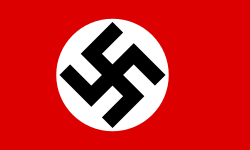| Flag | Date | Use | Description |
|---|
 | 987–1034 | Banner of the Kingdom of France | A Simple Blue Field. |
 | 1034–1215 | Banner of the Holy Roman Empire | A black eagle on a yellow field. |
 | 1339–1353 | Flag of the Republic of Genoa | A white field with centred red cross, similar to the Flag of England, but with five sestiere on the fly. [8] [9] |
 | 1353–1419 | Flag of the Crown of Aragon | Nine alternating horizontal stripes of yellow and red. |
 | 1419–1428
1688–1793 | Flag of Monaco | A white field with red lozenges. [10] |
 | 1428–1447
1450–1498 | Flag of the Duchy of Milan | the Imperial Eagle of the Holy Roman Empire in the first and fourth quarters and the Snake of Milan in the second and third quarters. |
 | 1447–1450 | Flag of the Golden Ambrosian Republic | A White Field With Red Centered cross and the emblem of the republic in the center. |
 | 1498–1525 | Flag of the Kingdom of France | A Blue Field With 3 Golden Fleur-de-lis. |
 | 1525–1641 | Flag of Habsburg Spain | A red saltire resembling two crossed, roughly-pruned (knotted) branches, on a white field. |
 | 1641–1688 | Flag of the Kingdom of France | A White Field With several Fleur-de-Lis and the royal coat of arms in the center. |
 | 1793–1814 | Flag of the French First Republic and the First French Empire | A vertical tricolour of blue, white, and red (proportions 3:2). |
 | 1814–1881 | Flag of Monaco | A White Field with the princely arms in the center. [11] |
 | 1815–1816 | Flag of the Kingdom of Sardinia | Blue with the cross of savoy and 2 St George's Crosses in the 1st and 4th quarters (one of them with four heads of Moors) occupying one quarter of the field and placed in the canton. [12] [13] |
 | 1816–1848 | Flag of the Kingdom of Sardinia | Blue with a combination of the crosses of savoy and St George occupying one quarter of the field and placed in the canton. [14] [15] |
 | 1848–1861 | Flag of the Kingdom of Sardinia | An Italian tricolour with House of Savoy shield in the center. |
 | 1881–1942 | Flag of Monaco | A horizontal bicolour of red and white. |
 | 1942–1943 | Flag of the Kingdom of Italy | An Italian tricolour with Savoy shield and Royal crown in the middle. [16] |
 | 1943–1945 | Flag of Nazi Germany | A red field, with a white disc with a black swastika at a 45-degree angle. Disk and swastika are slightly off-centre. [17] [18] |






















